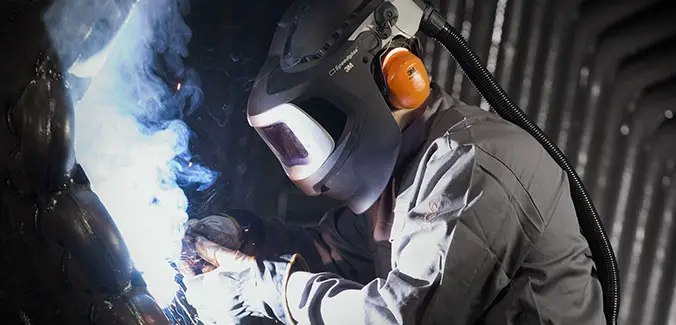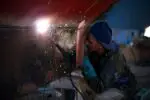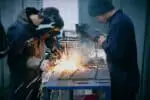The growing understanding of the health risks that are associated with welding has really altered the way welders operate and also the protective equipment they employ to keep themselves safe from welding hazards.
In this article, we assist you to understand the significance of selecting and using the suitable mask to ensure your health is not affected.
Welding masks, also known as helmets, are especially suited to protect you from welding hazards. Welders are aware that the fumes and chemicals emitted by their work might cause significant harm to their health.
And that is why wearing a mask while welding is essential because welding gases are known to cause major health concerns over time. While certain welding procedures are more hazardous than others, the smoke and fumes produced by all welding processes are extremely harmful to the body and especially, lungs.
Therefore, it is essential for welders to use masks, which prevent dangerous particles and smoke from entering the lungs.
These are not those regular masks that people use to protect them from pollution or even during the covid19 pandemic, but they are more heavy duty and are meant to block out 99 percent of the particles that employees may come into contact with.
Different Types of Welding Masks / Helmets
The following are some of the several types of welding helmets available today, and the descriptions should help you to understand which type of welding mask is suitable for you and your work.
1.) Welding Helmets With Auto-Darkening Lenses
These are excellent and reliable helmets because they detect the amount of light you’re working with and automatically adjusts the level of darkness suited for you to work with.
They are an improvement over earlier helmets that required manual adjustment, but they’re a little expensive as compared to other welding helmets in the market.
2.) Welding Helmet Powered by Batteries
These helmets make use of a lithium battery that lasts for very long, and many welders prefer this type of helmet over solar-powered helmets.
You must know that with these sorts of helmet, you must replace the batteries on a regular basis, but the batteries tend to last quite a long time, so you shouldn’t have to do it very frequently.
3.) Welding Helmet with a Fixed-Shade Lens
This helmet is ideal if you want to work on the same sort of job for an extended period of time.
The lens does not change to the quantity of light you are exposed to and remains the same shade, yet they are still inexpensive and efficient.
4.) Basic Welding Helmet
This is a basic welding helmet without all of the bells and whistles; yet, it is an excellent helmet for protecting yourself from flying debris and severe heat.
They are also incredibly inexpensive, so those on a tight budget will love them.
5.) Welding Helmet with Solar-Powered Lens
This is another sort of auto-darkening welding helmet that is powered by solar energy.
While some welders adore it, others despise it since it must be exposed to sunlight on a regular basis in order to function correctly.
Why Should you not Skip Wearing Masks While Welding?
1.) Fumes from Welding- Welding fumes are the most common airborne pollutant discovered in arc welding. Welding fumes is a complicated collection of very minute metal oxide particles.
The specific components are determined by the welding electrode composition (stick, wire, or filler rod), base metal, surface coatings, and shielding gas or flux type.
2.) Vapors and Gases- When electrode coatings, fluxes, shielding gases, and surface coatings are burnt or exposed to UV arc rays, potentially hazardous gases such as carbon monoxide, ozone, nitrogen oxides, gaseous fluoride, and phosgene are produced.
3.) Eye Protection- Helmets are frequently the first and final line of protection against a variety of possible sources of eye injury during the welding process. The main threat is infrared radiation, which is one of the leading causes of illnesses such as retinal burning and cataracts.
Welding arcs emit high levels of UV radiation, which can induce welder’s flash and, in some cases, irreversible eye damage.
Most helmets are available in a variety of viewing sizes for your convenience, without losing the substantial protective capabilities that keep problems at bay.
4.) Overall Head Protection- The eyes aren’t the only vital part of the head, and a decent helmet protects the complete head.
Sparks, excessive heat, and flying particles may all cause bodily harm in the welding profession, but with the correct helmet on, this is no longer a problem. Most of these particles will be imperceptible to you.
5.) Health Reasons- Welding fumes are composed mostly of metallic oxides, fluorides, and silicates. It’s not so great to be inhaling into your lungs.
When ventilation is insufficient to remove welding fumes or when there is a risk of oxygen deprivation, respiratory protection is required.
Respirators must be chosen and used in accordance with applicable rules. Seek professional assistance, do a danger assessment, and implement a suitable respiratory protection policy.
Different Welding Techniques and Fumes they produce
1.) TIG- Because of the nature of the arc, certain procedures, such as TIG, emit fewer emissions. A TIG weld frequently produces very little smoke, especially at low amperages.
This usually means that the welder is exposed to less dangerous chemicals.
2.) MIG- Smoke and sparks are common byproducts of high amperage stick welding and high voltage flux core MIG.
From a distance, you can see the massive cloud of smoke continuing to rise while a welder performs these steps. These processes are strenuous, and wearing a respirator can be extremely beneficial.
Conclusion
Wearing a mask is always a good idea since it is a responsible decision to safeguard your health and life. If you intend to weld full-time, you should consider the quantity of gases you may be exposed to over time.
Your future self will undoubtedly thank you for purchasing that respirator when you were younger.
Respirators come in a variety of sizes and types, so it may take some trial and error to locate one that suits you well.
Some welding hoods have a respirator – these PAPR hoods are quite beneficial, but they are pricey and uncommon. The most convenient option is to use a separate hood and a separate respirator that fit nicely together.








